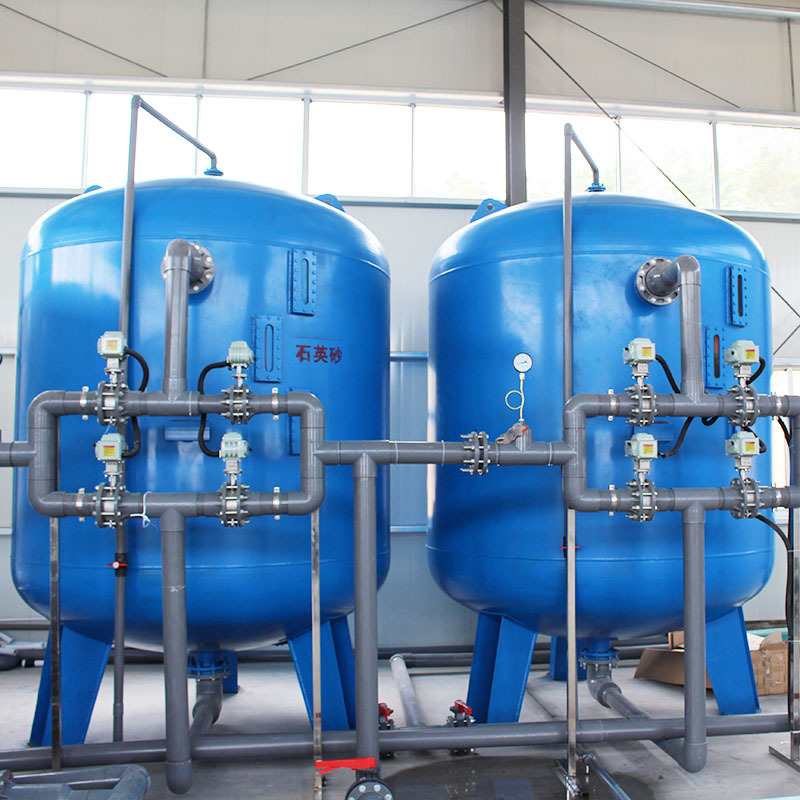Sand filtration is a process in which the treatment of the water is realized by the “porous” nature of a sand layer which traps particles present in water. Let’s see more clearly about this kind of water treatment technology.
The Working Principle of Sand Filter
The sand filter is one of the most beneficial methods for wastewater treatment. It is very environmentally friendly, relatively simple and affordable. Its principle entails percolating water through a sand bed.
Conceptually, the sand grains form a layer that is penetrated by water, and it acts like a simple sieve to prevent the separation between larger particles. When smaller particles come into contact with the grain as they pass through the filter, they also remain on the surface of the particles through a wall effect. The smaller the particle diameter, the longer the particles remaining in the filter, and the higher the filter’s stopping capacity.
Types of Sand Filtration
There are three types of sand filtration :
- Rapid sand filters. These filters require frequent back-washing, which involves reversing the direction of the water.
- Semi-rapid sand filters.
- Slow sand filters.
The first two require the use of pumps and chemicals. This means using flocculants and flocculation principle. The flocculant captures suspended matter and particles by chemical principles, and then form large flakes. These flakes are finally deposited by precipitation. (Precipitation means that suspended particles stop moving and settle).
Unlike other methods of sand filtration, slow sand filters are non-pressurized systems. They use biological processes to clean water. They can treat water without chemicals, but use a layer of activated carbon when necessary. They are effective in reducing the presence of microorganisms, such as viruses and bacteria. Another point to note is that these filters operate without electricity.

Who Use Sand Filtration And Since When ?
Since the 19th century, sand filtration as a technology has been used in water treatment systems around the world. Compared to other water treatment technologies, it is easier to use for water treatment in homes and emergency situations. It is eventually used in some wastewater treatment plants where initial wastewater treatment was provided.
Use of Rapid Sand Filters for Effluent Treatment
Rapid sand filters for wastewater treatment work efficiently by promoting the development of biological activities that decompose organic matter. They are part of wastewater treatment systems. When using this filter, the water must be pre-treated before filtering, otherwise, the filter will quickly and irreversibly clog.
Water flows vertically through rapid sand filters. There are two ways of process. One is that the water can be recovered from the bottom using a drainage pipe and then used for further processing. The other is that the water can be infiltrated underground. In the latter scenario, a comprehensive analysis has to be performed beforehand to avoid environmental pollution.
Rapid sand filters are supplied in the same way as vertically constructed wetlands. They need to be attached to a designed water scoop system (intermittent water splashing) so that each scoop quickly spreads evenly 10 to 15 cm of water on the filter. Stones must be placed below the feed point to prevent rinsing. Like vertically constructed wetlands, sand filters must be run alternately: 3 to 4 days and 7 days of idle time. This arrangement requires three filters in parallel.
In addition to eliminating pathogens, a depth of 80 cm is sufficient for conventional purification purposes. To achieve the latter, rapid sand filters must have greater depth (approximately 2.5 m), or it must undergo deeper pre-processing.
Slow Sand Filters Used to Make Water Drinkable
Slow sand filtration is only used for wastewater treatment. In fact, it was the first way used by many towns in the 19th century to treat rivers and streams before distributing them.
Slow sand filters can quickly eliminate the majority of the micro-organisms which cause water-borne ailments, such as protozoa, viruses and bacteria. Water flows slowly through 60 to 120 cm thick layers of sand. As water flows through, some physical and biological processes filter the water and remove pollutants. After a certain period of time, the sand layer contains a variety of bacteria, algae and aquatic microorganisms. These microorganisms help filter by eliminating contaminants. The sand containing these organisms is said to be “mature” and is best cleaned or replaced. Depending on the water and its temperature, this process can take weeks or months. The sand layer eventually became almost impermeable and slowed down the flow of water. It must then be cleaned, usually by back washing by changing the direction of the water flow.
Slow sand filters cannot treat chlorinated water because chlorine can have a deleterious effect on the filter’s microflora. If water must be chlorinated, it should only be done in a storage tank after the filtration process. Storing water before processing can adapt the network to various needs, as sand filtration systems cannot provide higher flows during periods of high demand. It will not reduce traffic during periods of low demand.
Slow sand filters are only suitable for low turbidity water, which contains very few algae and do not produce unpleasant colors due to pollution. They are not suitable for water with high algae or clay content. This kind of water tends to clog them. However, nutrient-rich spring water can help its cleaning effect by promoting the biological composition of its slow biofilter.
Slow sand filters usually have a fairly simple design. They require almost no maintenance and have low operating costs.
If you want to know more about sand filtration, please feel free to contact us. We, Jinwantong, have been dedicated to the development and manufacture of sand filter for 14 years. You can count on our expertise in this field.

